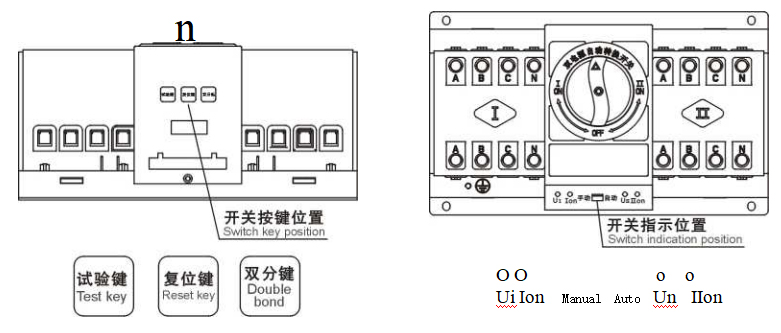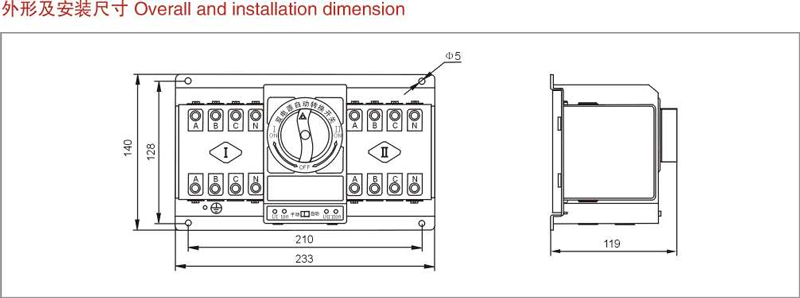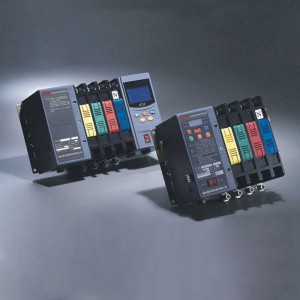SHIQ3-63(S) series dual power automatic transfer switch
Model and meaning

Structural features and functions
Switch can be realized automatic charge and automatic recovery, automatic charge and non-automatic recovery, firefighting function (forced to "0"), emergency manual operation: It also has the functions of phase detection protection, overvoltage protection, undervoltage protection and starting with generator (oil machine).
♦ Control type: A is basic type, B is intelligent type
A type is basic type function: loss of voltage (any phase) conversion, return to normal value return; its undervoltage, conversion and delay time can not be set.
Conversion mode
1. Automatic charge and automatic recovery: When the common power supply (I) power off (or phase failure), overvoltage and undervoltage, the switch will automatically switch to the standby power supply (II). And when the common power supply (I) back to normal, the switch automatically return to the common power supply (I).
2. Automatic charge and non-automatic recovery: When the common power supply (I) power off (or phase failure), overvoltage and undervoltage, the switch will automatically switch to the standby power supply (II). And when the common power supply (I) back to normal, the switch remains in the standby power supply (II) and does not automatically return to the common power supply (I).
Protection detection conversion function
1.Detection of common power supply arbitrary phase loss, loss of power protection conversion function.
2. Detection of common power supply arbitrary phase and N voltage: overvoltage 265V, under pressure 170V protection conversion function.
Fire-fighting function (forced to "0"): remote control and automatic conversion to "0" to cut off the load power supply, when the switch fire function (forced to "0") must be reset, you must manually press the switch "reset key" to restore to the automatic state.
Starting function of generator (oil machine)
Introduction to function of control and output terminals

1. Generator (oil machine)
Terminal ① is the normally open terminal NO of generator
Terminal ② is the public terminal COM of generator
Terminal ③ is the normally closed terminal NC of generator
2. I closing instructions:
④ and ⑤ terminals are common power supply (I) closing instructions, and the output voltage is AC220V.
3. II closing instructions:
⑥ and ⑦ terminals are standby power supply (II) closing instructions, and the output voltage is AC220V.
4. Fire fighting:
⑧ and ⑨ terminals are fire fighting function (forced to "0"), and the input voltage of DC24V.
Switch buttons and instruction function introduction:

1. Test key: Each time the test key is pressed, the common power supply (I) and the standby power supply (II) can be converted to each other. After the test key is pressed, the I on and II on indicator light flashes, which means it is the test status.
2. Reset key: Press the reset button to reset the switch to the automatic state, the e I on and II on indicator light does not blink.
3. Double bond: Force the switch to "0".
4. U I: the common power supply (I) indicating that when the U I indicator flashes, the common power supply is power failure.
5. U II: standby power supply (II) indication
6. 1 on: common power supply (I) closing indication
7. Hon: standby power supply (II) closing indication
Dial code switch and introduction of related functions
Function detailed as follows:
|
Function explanation |
|||||||||
| Fault confirmation delay setting |
1 |
OFF |
OFF |
ON |
ON | ||||
|
2 |
OFF |
ON |
OFF | ON | |||||
|
Duration |
OS |
1S |
3S | 5S | |||||
| Fault confirmation delay setting |
3 |
OFF |
OFF |
OFF | OFF |
ON |
ON |
ON |
ON |
|
4 |
OFF |
OFF |
ON | ON | OFF |
OFF |
ON |
ON |
|
|
5 |
OFF |
ON |
OFF | ON | OFF |
ON |
OFF |
ON |
|
|
Duration |
OS |
3S |
5S | 10S | 20S |
30S |
60S |
90S |
|
| Return delay setting |
6 |
OFF |
OFF |
ON |
ON | ||||
|
7 |
OFF |
ON |
OFF | ON | |||||
|
Duration |
OS |
1S |
3S | 5S | |||||
| Work mode settings |
8 |
OFF |
ON |
||||||
|
Mode |
Automatic charge and automatic recovery |
Automatic charge and non-automatic recovery |
|||||||

Wiring principle drawing











